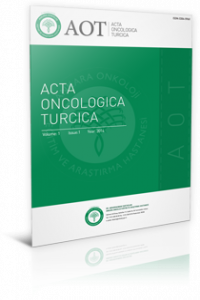Is Minimum 10 Nodes Removed to Correctly Determine The Breast Cancer Patients Who Had Negative Axillary Status Sufficient?
Meme kanseri, lenf nodu, aksiller disseksiyon, metastaz.
Meme Kanserinde Aksilla Negatif Olguları Doğru Belirlemek İçin En Az 10 Lenf Nodu Çıkarılması Yeterli midir?
Breast cancer, lymph nodes, axillary dissection, metastasis.,
___
- Clinical practice guidelines for the çare and treatment of breast cancer: A Canadian consensus document. Can Med Assoc J 1998;158:22-26.
- Golshirsh A, Wood WC, Senn H-J, et al. Meeting highlights International consensus panel on the treatment of primary breast cancer. J Natl Cancer Inst 1995;87:1441-5. 3.
- Henson De, Ries L, Freedman LS, et al. Relationship
- among outcome, stage of disease and histologic grade for
- 616 cases of breast cancer: The basis for a prognostic
- index. Cancer 1991;68:2142-9.
- Fisher ER, Anderson S, Redmond C, et al. Pthologic find- ings from the National Surgical Adjuvant Breast Project Protocol B-06: 10 year pathologic and clinical prognostic discriminants. Cancer 1993;71:2507-14.
- Veronesi U, Galimberti V, Zurrida S, et al. Prognostic signif- icance of number and level of axillary nodal metastases in breast cancer. Breast 1993;2:224-8.
- Maunsell E, Brisson J, Deshenes I. Arm problems and psy- chological distress after surgery for breast cancer. Can J Surg 1993;36:315-20.
- Singletary SE. Management of the axilla in early stage breast cancer. İn: Perry MC (ed.) American Society of Clinical Oncology educational book. Alexandria, VA: American Society of Clinical Oncology, 1998:132-41.
- Carter CL, Ailen C, Henson DE. Relation of tumor size, lymph node status, and survival in 24.740 breast cancer cases. Cancer 1989;63:181-7.
- Fitzgibbons PL, Page DL, VVeaver D, et al. Prognostic fac
- tors in breast cancer. College of American Pathologists con sensus statement 1999. Arch Pathol Lab Med 2000;124:966-78.
- Olivotto I, ColdmanA, Hislop G, et al. Compliance with prac tice guidelines for node-negative breast cancer. J Clin Oncol 1997;15:216-22.
- Sawka C, Olivotto I, Coldman A, et al. The association between population-based treatment guidelines and adju vant therapy for node-negative breast cancer. Br J Cancer 997:75:1534-42.
- Steele R, ForrestA, Gibson T, et al. The efficacy iovver axil- lary sampling in obtaining lymph node status in breast can cer: A controlled randomized trial. Br J Surg 1985;72:368- 69.
- ForrestA, Everington D, Mc Donald C, et al. The Edinburgh randomized trial ofaxillary sampling or clearance after mas- tectomy. B rJ Surg 1995;82:1504-8.
- Baslaim MM, Al Malik OA, Al-Sobhi SS, et al. Decreased axillary lymph node retrieval in patients after neoadjuvant chemotherapy. Am J Surg 2002;184:299-301.
- Weir L, Speers C, D’yachkova Y, et al. Prognostic signifi- cance of the number of axillary lymph nodes removed in patients with node-negative breast cancer. J Clin Oncol 2002;20:1793-9.
- Van der Wal BC, Butzelaar RM, van der Meij S, et al. Axillary lymph node ratio and total number o f redmoved lymph nodes: Predictors of survival in stage I and II breast cancer. Eur J Surg Oncol 2002;28:481-9.
- Sosa JA, Diener-West M, usev Y, et al. Association betvveen tent of axillary node clearance and survival in patients with stage I breast cancer. Ann Surg Oncol 1998;5:140-9.
- Somner A, Dixon J, Thomas J. Node retrieval in axillary node dissections: Recommendations for minimum numbers to be confident about node negative status. J Clin Pathol 2004;57:845-8.
- Kutiyanawala MA, Sayed M, Stotter A, et al. Staging the axilla in breast cancer: An audit of lymph-node retrieval in one U.K. regional centre. Eur J Surg Oncol 1998;24:280-2.
- VoogdAC, Coebergh JW, Repelaer van Driel OJ, et al. The risk of nodal metastases in breast cancer patients with clin- ically negative lymph nodes: A population-based analysis. Breast Cancer Res Treat 2000;62:63-9.
- ISSN: 0304-596X
- Başlangıç: 2015
- Yayıncı: Dr. Abdurrahman Yurtaslan Ankara Onkoloji EAH
Fetal Ouadrigeminal Arachnoid Cyst Secondary to Usage of Valproic Acid
Gülşah Bayram KABAÇAM, Z. Nilgün Yildirim ÖZBAY, Bige SAYIN, Perihan SOYDİNÇ, Doğan DEDE
The Treatment Modalities in Sacral Chordomas
Şafak GÜNGÖR, Yaman KARAKOÇ, Deniz GÜRLER, Burak ATALAY, Ataç KARAKAŞ, Murat ARIKAN
Seroprevalerıce of Anti-HDV Antibody in HBsAg Positive Patients
Gülşen İSKENDER, M. Cihat OĞAN, Kamuran SAYILIR, Ece BİLEN DİRİM, Sema BATI, Müfide ÇİMENTEPE, Ayla YENİGÜN
The Efficacy of US-Guided Fine-Needle Aspiration Biopsy in Adrenal Masses
Bilgin Kadri ARIBAŞ, Gürbüz DİNGİL, Ümit ÜNGÜL
Management of Menopausal Symptoms in Patients Breast Cancer
Oğuz TARCAN, Haluk ULUCANLAR, Aybala AĞAÇ, Suat KUTUN, Necmi YÜCEKULE, Abdullah ÇETİN
Kaptan GÜLBEN, Mustafa YİĞİT, Uğur BERBEROĞLU
Metachronous Thymoma and Nonsmall Celi Lung Cancer A Case Report
Yeşim ELGİN, Aytül ÖZGEN, Bülent KÜÇÜKPLAKÇI, Ergun SANRI, Cem MISIRLIOĞLU, Taciser DEMİRKASIMOĞLU, V. Işıl UĞUR, Ş. Pınar KARA, Nadi ÖZDAMAR
Evaluation of Quinolone Susceptibility in Orthopedic Infections
Kamuran SAYILIR, M. Cihat OĞAN, Gülşen İSKENDER, Müfide ÇİMENTEPE, Yaman KARAKOÇ
